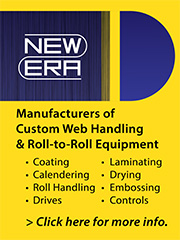Coating Matters | Suspensions, Dispersions, and Emulsions
- Published: February 22, 2012, By Mark Miller
If you'd like to hear from Mark Miller's own lips rather than read his column, titled " Coating Matters | Suspensions, Dispersions, and Emulsions," click on his podcast below:
{mp3}suspensions-dispersions-emulsions{/mp3}
What variables need to be considered when coating a fluid that isn't simple?
When coating a simple fluid, slot die coating operators have enough to worry about if the fluid is a chemical or polymer diluted by a solvent. Viscosity curves at various shear rates and temperatures, stress relaxation of elastomeric materials, and flow dynamics within the slot die manifold geometry are swimming around in your mind as adjustments are made to the physical coating head to adjust for the many variations. Today’s production applications sometimes require solid particles or mixtures to be coated within the confines of the slot die manifold. Let’s discuss what variables need to be considered when the fluid is no longer “simple.”
Suspensions
When particles are being sent through a slot die for a coated product, the most important issue is to keep the particles in suspension. This concern works against the design of the slot die, as the internal manifold is designed to place the fluid on the substrate at a consistent velocity at the exit of the coating head. To obtain a consistent velocity, the slot die manifold is designed with a series of expansions and contractions that can create agglomeration points for the suspended particles. The key to success with a suspension is to know the time the particles take to fall out of suspension. This time needs to be longer than the residence time calculated in the slot die manifold. This manifold residence time can be obtained from the slot die manufacturer.
Dispersions
Suspensions are actually a subset of dispersions, but there are some important differences. In a suspension for fluid coating, the solid particle is floating in the fluid but maintains the solid state that allows for separation, such as clay particles in alcohol. In a dispersion, the solid may be more difficult to separate, such as sugar in water. While the sugar could be chemically extracted from the water, we have less concern about the solids dispersed in the fluid than we do with suspensions. The key with dispersions is to verify that the initial mixing has occurred and is stable.
Emulsions
Yet another subset of dispersions is an emulsion or liquid-liquid mixture. Emulsions mix two fluids that don’t like each other, and try to keep the fluids from separating. The classic example is oil and water. If you want oil and water to stabilize long enough to be useful, you need to add an agent to promote the mixture. This is how detergents work: the surfactants in the detergent stabilize the oil and the water to allow you to clean a surface and remove the grease from the proverbial frying pan. With emulsions, the strength of the liquid-liquid bond is strong enough to survive the slot die manifold stresses, but care needs to be taken to understand the stress and strain phenomena related to the fluids that are emulsified.
Whether your head was swimming with data and charts before or not, I hope this breakdown of fluid systems has calmed the waters and provided you with a clear vision for improved coating performance.
Roll-to-roll coating industry expert Mark Miller, owner of Coating Tech Service, has 14+ years of slot die coating experience and troubleshooting. Contact him at 715-456-9545; mark@coatingtechservice.com; www.coatingtechservice.com.







